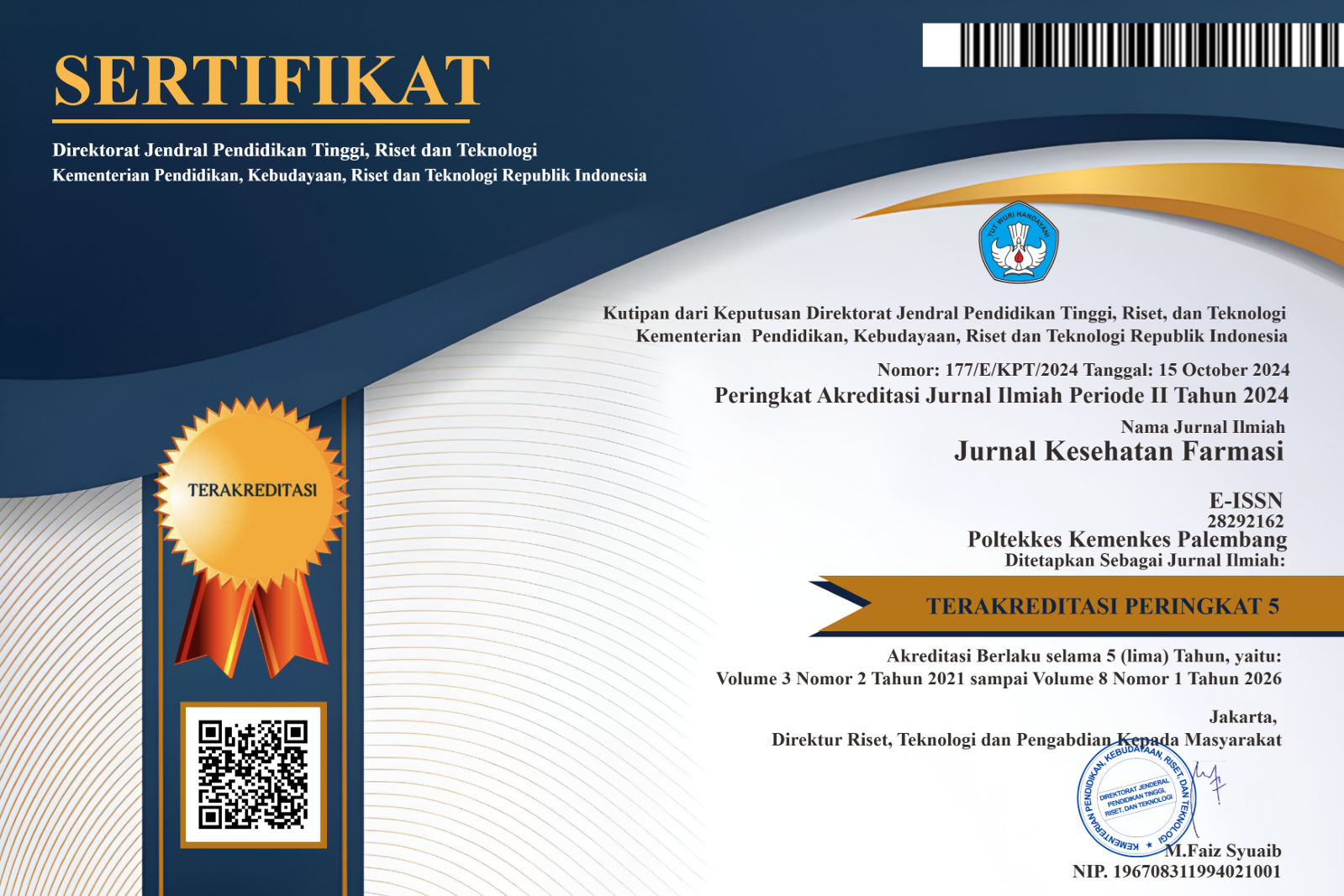Formulasi dan Evaluasi Spray Gel Anti Jerawat Ekstrak Kayu Secang (Caesalpinia sappan L.) dengan Variasi Konsentrasicarbopol 940 Sebagai Gelling Agent
Abstract
Latar Belakang : Spray gel merupakan bentuk pengembangan sediaan gel. Salah satu komponen yang perlu diperhatikan dalam memfomulasikan sediaan spray gel adalah konsentrasi pembentuk gel yaitu carbopol 940 yang merupakan polimer pembe ntuk gel yang sering digunakan. Penelitian ini bertujuan untuk mengetahui konsentrasi carbopol 940 yang dapat menghasilkan spray gel yang stabil dan memenuhi persyaratan dengan zat aktif kayu secang (Caesalpinia sappan L.) yang berfungsi sebagai anti jerawat.
Metode : Penelitian ini menggunakan metode eksperimental, dengan esktrak kayu secang (Caesalpinia sappan L.) sebagai zat aktif yang diformulasikan dalam sediaan spray gel dengan memvariasikan konsentrasi carbopol 940. Konsentrasi zat aktif yang digunakan dalam setiap formula adalah 1% serta konsentrasi carbopol 940 sebesar 0,4% pada formula I, 0,5% pada formula II dan 0,6% pada formula III. Kemudian dilakukan evaluasi sediaan pada suhu kamar dan uji dipercepat (cycling test) meliputi pH, viskositas, homogenitas, daya sebar, kondisi semprotan, warna, bau, dan iritasi kulit.
Hasil : Berdasarkan hasil yang didapat, pH dan daya sebar sediaan pada kedua uji penyimpanan suhu kamar maupun uji dipercepat (cycling test) mengalami kenaikan namun masih memenuhi syarat. Ditinjau dari homogenitas, kondisi semprotan, warna, bau, dan iritasi kulit semua formula stabil dan memenuhi syarat selama penyimpanan suhu kamar dan uji dipercepat (cycling test). Adapun formula yang paling optimal adalah formula I dengan konsentrasi carbopol 940 sebesar 0,4%.
Kesimpulan : Ekstrak kayu secang (Caesalpinia sappan L.) dapat diformulasikan menjadi sediaan spray gel yang stabil dan memenuhi syarat. Formula yang paling optimal dengan konsentrasi carbopol 940 sebesar 0,4%.
Kata Kunci : Anti Jerawat, Spray Gel, Kayu Secang, Carbopol 940, Gelling Agent
ABSTRACT
Background : Spray gel is a form of development of gel preparations. One of the components that need to be considered in formulating spray gel preparations is the concentration of gelling agent, namely carbopol 940 which is a gelling polymer that is often used. This study aims to determine the concentration of carbopol 940 which can produce a stable spray gel and meet the requirements with the active substance of sappan wood (Caesalpinia sappan L.) which functions as an anti-acne.
Methods : This study used an experimental method, with sappan wood extract (Caesalpinia sappan L.) as the active substance formulated in spray gel preparations by varying the concentration of carbopol 940. The concentration of the active substance used in each formula was 1% and the concentration of carbopol 940 was 0,4% in formula I, 0,5% in formula II and 0,6% in formula III. Then the preparation was evaluated at room temperature and accelerated test (cycling test) including pH, viscosity, homogeneity, dispersion, spray conditions, color, odor, and skin irritation.
Results : Based on the results obtained, the pH and dispersion of the preparation in both the room temperature storage test and the cycling test increased but still met the requirements. In terms of homogeneity, spray conditions, color, odor, and skin irritation, all formulas were stable and met the requirements during storage at room temperature and accelerated test (cycling test). The most optimal formula is formula I with carbopol 940 concentration of 0,4%.
Conclusion : Secang wood extract (Caesalpinia sappan L.) can be formulated into a spray gel preparation that is stable and meets the requirements. The most optimal formula with carbopol 940 concentration of 0,4%.
Keywords : Anti Acne, Spray gel, Sappan Wood, Carbopol 940, Gelling Agent
Copyright (c) 2021 JKPharm Jurnal Kesehatan Farmasi

This work is licensed under a Creative Commons Attribution-ShareAlike 4.0 International License.
Authors who publish with this journal agree to the following terms:
- Authors retain copyright and grant the journal right of first publication with the work simultaneously licensed under a Creative Commons Attribution License that allows others to share the work with an acknowledgement of the work's authorship and initial publication in this journal.
- Authors are able to enter into separate, additional contractual arrangements for the non-exclusive distribution of the journal's published version of the work (e.g., post it to an institutional repository or publish it in a book), with an acknowledgement of its initial publication in this journal.
- Authors are permitted and encouraged to post their work online (e.g., in institutional repositories or on their website) prior to and during the submission process, as it can lead to productive exchanges, as well as earlier and greater citation of published work














